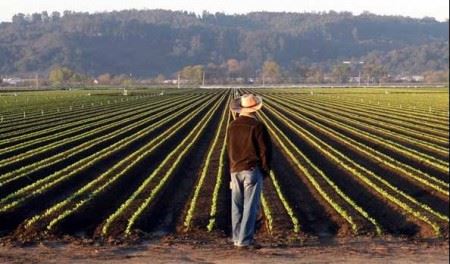California remains the nation’s agricultural powerhouse despite a myriad of natural and human-made challenges. The agricultural nation-state produces over 400 different crops or commodities, with about $60 billion in annual cash receipts for their output, according to the California Department of Food & Agriculture, making it the leading producing state in the U.S.
California also is the leading farm-export state in the U.S. California agricultural exports total about $24 billion, according to the University of California Department of Agricultural and Resource Economics. Tree nuts and dairy products are the state’s leading export commodities.
In 2025, California’s top ten commodities – milk and dairy products (about $8.13 billion annually), grapes ($6.52 billion), cattle and calves ($4.76 billion), lettuce ($3.93 billion), almonds ($3.88 billion), pistachios ($2.98 billion), strawberries ($2.97 billion), tomatoes ($2.01 billion), carrots ($1.67 billion) and broilers (1.24 billion) – continue to shape the state’s agricultural landscape, as they have for a number of previous years. As these 10 top crops and commodities go, so goes California agriculture from an economic standpoint.
Four key issues – water, labor availability, input costs (energy, fertilizer, ect.) and exports/tariffs – will primarily shape California’s major crop outlook this year.
For example, California Farm Bureau President Shannon Douglas recently laid out the key challenges for farmers and agriculture in California for 2025, which include “securing a sustainable water supply, tackling labor shortages, passing a full reauthorization of the farm bill, improving trade policies and reducing the high costs and regulatory burdens that farmers and ranchers face.”
President Trump, who won the majority of the vote in most of California’s farm counties, has promised to get more irrigation water for California farmers and reduce input costs primarily through increased energy production and deregulation. This is something farmers and groups like the Farm Bureau say they support.
Of greater concern in California agriculture is President Trump’s promises to impose increased tariffs on countries like China, Canada, Mexico and others. The fear is that should he follow through with the tariffs, these countries will impose retaliatory tariffs on the U.S. like happened during his first term, resulting in reduced exports of California-grown crops. The jury is still out on how new tariffs would impact California commodity exports. Key is if the various countries fire back with retaliatory tariffs targeting the leading California export crops.
The California major crop outlook for 2025 will largely depend on the four key factors noted above, along with any surprises – and it seems like surprises do pop up year-after-year when it comes to California agriculture – that come our way this year.
Here’s a look (part analysis and part prognostication) at the California major crop outlook for this year, focusing on the 10 leading crops and commodities produced in the Golden State.

Milk and Dairy Products
Milk and dairy products remain the cornerstone of California’s agricultural economy, contributing significantly to the state’s gross farm receipts. However, the dairy industry in 2025 faces mounting challenges. Drought conditions and water scarcity, persistent issues in California, continue to strain alfalfa production, a key feed crop for dairy cattle. Additionally, rising feed costs and labor shortages are pressuring profit margins. The bird flu is also causing significant problems on dairy farms and egg ranches. Unless brought under control it has the potential to cause even more significant losses to the dairy and poultry industries than it already has. Despite these major hurdles, the California dairy industry continues to hold its own and will survive the many challenges it’s currently facing.
Grapes
Grapes, integral to California’s wine industry and fresh fruit market, are poised for a mixed outlook in 2025. While premium wine exports remain strong (domestic demand for all wine is down though) table grape growers face increased competition from international markets. Climate change continues to challenge grape production, as shifting weather patterns affect flowering and harvest timing. To counter these issues, many vineyards are investing in drought-resistant grape varieties and innovative irrigation techniques. Additionally, sustainability practices, such as reduced pesticide use and carbon footprint monitoring, are becoming standard in the industry, appealing to environmentally conscious consumers.
Cattle and Calves
The cattle and calves sector in California faces a dynamic landscape in 2025. Rising input costs, including feed and water, remain significant challenges. The ongoing drought has reduced pasture availability, prompting many ranchers to adopt rotational grazing systems and supplemental feeding strategies. On the demand side, consumer preferences for sustainably raised and grass-fed beef are driving changes in production practices. California’s proximity to major urban markets ensures steady demand for beef, but the industry’s future growth hinges on addressing environmental concerns and maintaining competitive pricing.
Lettuce
Lettuce, a staple of California’s vegetable industry, is experiencing both opportunities and threats in 2025. Innovations in controlled environment agriculture (CEA), such as vertical farming and hydroponics, are reshaping lettuce production by reducing water use and ensuring year-round supply. However, disease outbreaks, particularly lettuce dieback and downy mildew, remain persistent issues. Labor shortages and increasing production costs further complicate the outlook. To mitigate these challenges, growers are adopting mechanization and collaborating with researchers to develop disease-resistant lettuce varieties.
Almonds
Almonds, California’s leading export crop, continue to face scrutiny over their water-intensive nature. In 2025, the almond industry is at a crossroads. While global demand for almonds remains robust, water regulations and sustainability pressures are forcing growers to innovate. Practices such as micro-irrigation, soil moisture monitoring, and the use of cover crops are becoming widespread. Additionally, efforts to reduce carbon emissions in processing facilities and enhance pollinator health are gaining traction. Despite these challenges, California’s almond sector remains a vital contributor to the state’s agricultural economy. Potential retaliatory tariffs, particularly from top export countries like Canada, China, India and Mexico, are a major concern of the California almond industry. About 70% of California’s almonds are exported, which means exports are a key source of revenue for California almond producers.
Pistachios
Pistachios have seen steady growth in acreage and production in California. In 2025, the outlook for pistachios remains favorable, driven by strong global demand, particularly from Asian and European markets. However, geopolitical tensions and trade uncertainties pose risks to exports. California growers are investing in improved harvesting technologies and pest management practices to maintain high yields and quality. The industry’s focus on sustainability and water efficiency is expected to bolster its long-term viability. Domestic demand for pistachios will continue to hold in 2025 as well. Pistachios have become the “hot” snack nut in America and elsewhere.
Strawberries
California’s strawberry industry will continue to do well in 2025 (barring one of those big surprises), though it is not without challenges. Rising labor costs and competition from Mexico are pressing concerns. However, advances in automated harvesting technologies and high-yielding strawberry varieties are helping mitigate these issues. The demand for organic strawberries is growing, prompting many farmers to transition to organic practices despite higher production costs. Additionally, efforts to extend the growing season through the use of protective structures and climate-controlled environments are boosting productivity. Strawberries, along with other berries, are also benefiting from their health and wellness attributes, which will continue to increase demand nationally.
Tomatoes
Tomatoes, a versatile crop used in fresh markets and processed products, face a complex outlook in 2025. Water scarcity and rising production costs are significant challenges for California’s tomato growers. However, advancements in drip irrigation and fertigation (the process of applying water and dissolved fertilizers to plants through an irrigation system) are helping optimize resource use. The processed tomato industry, which includes products like paste and sauces, remains a key driver of demand. Consumer interest in organic and locally sourced tomatoes is also shaping production practices. Despite the challenges, California will remain a dominant player in the U.S. tomato market.
Carrots
California’s carrot industry continues to benefit from the state’s ideal growing conditions. In 2025, demand for fresh and processed carrots remains strong, driven by their popularity as a healthy snack and ingredient. However, labor shortages and water limitations pose challenges for growers. Mechanization and the adoption of drought-tolerant carrot varieties are helping mitigate these issues.
Broilers
Broilers, while not as prominent as other commodities in California, play a critical role in the state’s agricultural output. The number one challenge to broiler production right now is bird flu (HPAI), which has infected numerous commercial poultry flocks in the state. Over 1.5 million birds, including broiler chickens, to date have been culled to contain the virus. Additionally, in 2025, the broiler industry faces growing demand for antibiotic-free and pasture-raised chicken. Producers are responding by adopting improved biosecurity measures and investing in sustainable feed options. Despite these issues, California’s proximity to large urban markets ensures a steady demand for broilers, particularly among health-conscious consumers.
Challenges and Opportunities
The 2025 outlook for California’s top crops and commodities underscores the complexities of modern agriculture. Water, labor availability, input costs (energy, fertilizer, ect.) and exports/tariffs are pervasive challenges that cut across all sectors.
However, these challenges also present opportunities for innovation. Investments in technology, such as precision agriculture, automation, and sustainable farming practices, are reshaping the industry. More water for irrigation and a steady and reliable labor force remain essential for the continued success of California agriculture though.
This year is a pivotal one for California agriculture. For example, according to the California Farm Bureau, over the last 5 years the state has lost more than 7,000 farms and fallowed about 1.5 million acres of productive lands, all while input costs increased more than $150,000 per farm. This is a dangerous trend that needs to be reversed.
California’s agricultural sector in 2025 remains a vital component of the state’s economy and the nation’s food supply. While challenges such as water, labor availability and the others persist, the resilience and adaptability of California’s farmers and ranchers offer hope for a sustainable future. By embracing innovation and sustainability, the state’s top crops and commodities – dairy products, grapes, cattle and calves, lettuce, almonds, pistachios, strawberries, tomatoes, carrots, and broilers – can continue to thrive, ensuring California’s position as a global leader in agriculture.
My Job Depends on Ag Magazine columnist and contributing editor Victor Martino is an agrifood industry consultant, entrepreneur and writer. One of his passions and current projects is working with farmers who want to develop their own branded food products. You can contact him at: [email protected].







